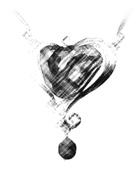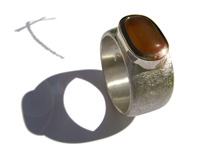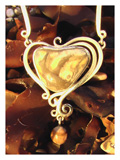|
HOME...
A UNIQUE ETHOS » LAIBACH
PRINCIPLES » LOCALLY GATHERED
 Laibach
"Eco-Locally-Gathered" and "Thrucycling". Laibach
"Eco-Locally-Gathered" and "Thrucycling".
The cost of precious
stones set in intricate metalwork is traditionally reflected in
the substantial prices paid for bespoke jewellery. The detail
similarly found in Laibach pieces interlaced with naturally-formed
surface-stones, instead means that the price of each piece is
calculated through alternative costing. For example, our "re-naturing
costs" can be expenses incurred through selecting our materials
and time-intense administration and liaison with select organisations
to establish the ecological benefits the pieces can offer through
Kerstin Laibach sales donations.
Our evaluation methods in slow, ethical jewellery creation using
non-precious stones (see below) are in stark contrast to adding
on current market values of environmentally damaging fresh-mined
gemstones. So although a Laibach piece may be a little cheaper
(because unlike a gem, a common pebble has no intrinsic value)
our subsequent end cost reflects the following:
- The selection process: To instinctively
recognise how a stone can look and feel perfect for a centrepiece
is a gathering skill in itself.
- Research and ecological liaison
with conservation and wildlife organisations: To determine
how a percentage of the sold piece will benefit the environment
/ wildlife near the vicinity where (for example) the centre
stone originated.*
- Time: The selection and design
process, and from thereon the elaborate hand-crafting which
involves the making of every aspect of a piece, including
chains and closing mechanisms. (Kerstin Laibach does not use
off-the-shelf factory made "findings" or "ring
blanks".)
Using safe but slower alternatives in all treatment processes
during the crafting of your piece.
You may wonder if
there are environmental consequences when gathering beach stones.
Beach stones may seem to be in abundance - sometimes many billions
along a few miles of coast. But on an industrial scale there can
of course be an adverse effect on beach environments when stones
are removed by the ton to cover patios and driveways or for other
building purposes. Some local authorities and trusts, in Great
Britain for example, do not encourage pebble collecting from beaches
and some environmentally sensitive areas don't allow you to remove
any. However, one or two pebbles for a keepsake memory from permissible
areas, where nature would not be adversely affected, is usually
OK.
Laibach collects just a small handful of stones each year - and
often from domestic (man-laid "shingle") paths and driveways.
Even in such places we only gather a tiny amount within the acceptable
ecological tolerance of Laibach's principles. We reciprocate with
nature by donating a sales percentage to local wildlife, conservation
and re-naturing organisations. It is important to stress that
the environment actually benefits far more than Laibach takes
from it:
- Laibach never digs or breaks
rocks to reveal usable stones.
- Approximately one hundred stones
per year are collected.
- Stones not used are returned
back to the same gathering spot
- We are currently researching
the geological aspect and lawfulness of returning former beach
stones (that have been extracted from beaches by the ton for
home driveways and patio features) back to beaches that need
them most to help combat sea erosion. In practice, this would
be a handful of geologically suitable "driveway"
beach pebbles taken back to the beach of similar geological
character in exchange for one stone used in a Laibach piece
... meaning that more pebbles would be returned to their natural
surroundings than extracted from it. The anomalies of UK law
may mean that even such an environmentally positive action
is not legally permissible. This page will be updated accordingly
if and when we are able to put this principle into practice.
Through special liaison
with more environmentally distinguishable areas in Europe, Laibach
gathers a few surface stones to make pieces which directly benefit
the overseeing conservation organisation in the gathering area
with donations. As an example of how Laibach works in harmony
for the benefit of conservation in central Europe, we are building
a particularly effective relationship with TRUZ (near the Laibach
atelier in southwest Germany). This important tri-regional organisation
runs essential conservation and re-naturing projects in the area
of France, Switzerland and Germany around the Rhine River. With
joint publicity, TRUZ with Atelier Laibach are able to inform
and educate the public as well as encourage similar creative businesses
to minimise or reverse their carbon footprint with directly beneficial
actions towards nature.
Where
are the stones Eco-Locally-Gathered?
The primary regions
where stones are sourced are nearly always close to where each
Laibach workbench is based: South West England and Baden Württemberg
in South West Germany. Other stones may be gathered from elsewhere
in the event of essential or customary travel, (Combined Travel
Gathering). With all aspects of travel, Laibach gathering is undertaken
using the most environmentally friendly transport options whenever
possible.
We also occasionally create pieces or small collections made from
surface gathered stones sent to us by friends and colleagues from
other regions of the world. These stones are gathered and transported
strictly in accordance with our principles. A percentage of the
sale of pieces made from these stones is awarded to relevant wildlife
/ environmental protection or humanitarian-based organisations
near the gathering regions.
* A NOTE ABOUT THE BRITISH STONES:
The names given to Laibach pieces with British stones are sometimes
place names. Such names do not reflect the actual source from
where the stone in the piece was gathered. Where applicable, all
stones used are permissibly gathered or occasionally chosen from
an inherited 50 year old small collection of pebbles once gathered
from around southern areas of the UK.
 This
photo shows a Laibach design, created using a customer's own self-gathered
stone found on a Baltic Sea beach. If you are thinking of gathering
your own stones for a keep-sake memory - or for us to make a special
piece for you, you can find
out more here. This
photo shows a Laibach design, created using a customer's own self-gathered
stone found on a Baltic Sea beach. If you are thinking of gathering
your own stones for a keep-sake memory - or for us to make a special
piece for you, you can find
out more here.
What
is "Eco-Locally-Gathered" and "Thrucycled?
"Eco-Locally Gathering"
and Thrucycling" are principles of the Looking-Glass philosophy,
actively adopted by Kerstin Laibach as the preferred choice to
source raw creative materials. Here is an extract from Looking-Glass:
"Eco-Locally-Gathered
(ELG) is essentially the same ethos as "locally produced" or
locally grown; describing consumables and goods sourced or manufactured
from the immediate area where you live thus reducing product
mileage. Eco-Local can apply to anything which can be locally
sourced with absolute minimal environmental impact. For example,
wild vegetation and fungi for food - fallen trees or driftwood
for carpentry - even discarded nontoxic junk from neighbours
or local industries, which you can turn into something useful.
Like all locally gathered, grown, or manufactured instances,
the less miles involved the greener the product, because the
carbon footprint that would otherwise be generated by the movement
of materials through long-distance transportation is greatly
reduced ...".
" Thrucycling is the ultimate "earth to earth"
environmentally friendly production method whereby crafters
and manufacturers reclaim materials to make items which can
be safely returned to the earth at the end of its usefulness
(or can otherwise be upcycled to make something new with). For
example, a wood carver or carpenter may make an new item from
an old staircase. The new item is made without using toxic or
non-biodegradable materials. After the item has served its purpose
it can either be put in for recycling or reclamation ... or
most importantly if it is useless for any further purpose it
can be returned to the ground where it can naturally decompose
without detriment to the environment. Items such as metal-works
and jewellery can be made in this way too if using only recycled
metals (and reclaimed gems from old broken jewellery). Providing
there is nothing new-mined or plastics in the product, and is
chemical-free, it can be continually thrucycled (with the metals
being refined again... or even if lost to the earth from where
it came, the item would be non-hazardous ..."
Laibach's pebbles are
often sourced from areas geographically close to the workbench.
This dramatically reduces the production miles involved in making
a piece. In stark contrast, the production miles involved with
the mining and transportation of precious stones, the cutting
of them and subsequent journeys from one dealer worldwide to another
amounts to a huge carbon footprint.
All Laibach jewellery
is earth-to-earth "thrucycled". We do not use new-mined
precious metals, only recycled. If for any reason a Laibach piece
ended up back in the ground, the components are natural, non-toxic
materials and pose no detriment to the environment. All Laibach
jewellery is also recyclable.
Creating goldsmith
quality jewellery pieces from meticulously chosen "pebbles" is
an extremely skilled craft and we do not encourage or have any
connection with dilettante pebble jewellery making, particularly
in bulk, which presents no return benefit for the environment.
NOTE: Never take quantities
of pebbles from sea, river or lake shores ... (in less sensitive
areas it may be acceptable to gather one or two for keepsake or
occasional craft use ... and even then, always return those which
you have no further use for).
Laibach can also create
bespoke pieces from stones which you have gathered yourself.
Find out More
FINALLY: Whichever
Laibach piece you chose you can be assured that nothing about
it is newly-mined or dug up. Only recycled precious metals and
surface gathered stones are used, causing no damage to nature.
And because we give a percentage of the sale of your piece to
re-naturing, our precious eco-systems can benefit more in return
than what we have taken from it.
(We had to make up an ethical term for this and we call it our
"Carbon-Reversal Principle"!)
MORE
INFORMATION ...
Atelier
Laibach's commitment to wildlife and the environment
About
the South and Southwest areas of England
About
the Baden-Württemberg area (Lake Constance and the Rhine)
 ALSO
... ALSO
...
A
Creation from Your Own Gathering Memory
The
Laibach Principle
Contact
and Discuss Your Piece
|